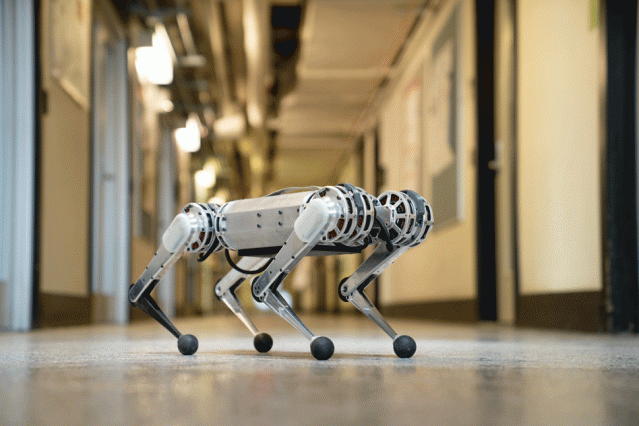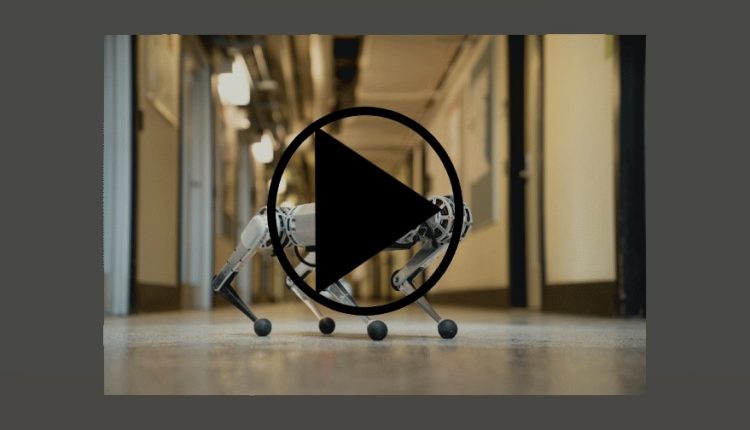One thing tech-lovers go crazy for is a good robot video. This one from Massachusettes Institute of Technology displays the newest addition to its robot family: a mini-cheetah robot. The lightweight robot can bend and swing its legs and is capable of walking straight-up and even upside down.
The robot can also trot over uneven terrain about twice as fast as an average person’s walking speed. The robot weighs just 20 lbs. but has a fighter personality. When it’s knocked over, it swiftly gets back up with a swing of its elbows.
One of its most impressive features is its ability to perform a 360-degree backflip from a standing position. Researchers claim the mini cheetah is designed to be “virtually indestructible,” recovering with little damage, even if a backflip ends in a spill.
But, accidents happen and nothing is guaranteed. That’s why the researchers designed the cheetah with modularity in mind. Each of the robot’s legs is powered by three identical, low-cost electric motors that the researchers engineered using off-the-shelf parts. Each motor can easily be swapped out for a new one.
“You could put these parts together, almost like Legos,” says lead developer Benjamin Katz, a technical associate in MIT’s Department of Mechanical Engineering.
The mini-cheetah developers are currently building more of the four-legged machines, aiming for a set of 10, each of which they hope to loan out to other labs.

“A big part of why we built this robot is that it makes it so easy to experiment and just try crazy things, because the robot is super robust and doesn’t break easily, and if it does break, it’s easy and not very expensive to fix,” says Katz, who worked on the robot in the lab of Sangbae Kim, associate professor of mechanical engineering.
Kim hopes that one day they’ll be able to conduct robotics dog races through obstacle courses and each team could control their robots with different algorithms to see which strategy wins.
The Technical Stuff: What’s Inside?
The mini cheetah is more than just a miniature version of its predecessor, Cheetah 3, a large, heavy, formidable robot, which often needs to be stabilized with tethers to protect its expensive, custom-designed parts.
“In Cheetah 3, everything is super-integrated, so if you want to change something, you have to do a ton of redesign,” Katz says. “Whereas with the mini cheetah, if you wanted to add another arm, you could just add three or four more of these modular motors.”
Katz came up with the electric motor design by reconfiguring the parts to small, commercially available motors normally used in drones and remote-controlled airplanes.
Each of the robot’s 12 motors is about the size of a Mason jar lid, and consists of: a stator, or set of coils, that generates a rotating magnetic field; a small controller that conveys the amount of current the stator should produce; a rotor, lined with magnets, that rotates with the stator’s field, producing torque to lift or rotate a limb; a gearbox that provides a 6:1 gear reduction, enabling the rotor to provide six times the torque that it normally would; and a position sensor that measures the angle and orientation of the motor and associated limb.
Each leg is powered by three motors, to give it three degrees of freedom and a huge range of motion. The lightweight, high-torque, low-inertia design enables the robot to execute fast, dynamic maneuvers and make high-force impacts on the ground without breaking gearboxes or limbs.
“The rate at which it can change forces on the ground is really fast,” Katz says. “When it’s running, its feet are only on the ground for something like 150 milliseconds at a time, during which a computer tells it to increase the force on the foot, then change it to balance, and then decrease that force really fast to lift up. So it can do really dynamic stuff, like jump in the air with every step, or run with two feet on the ground at a time. Most robots aren’t capable of doing this, so move much slower.”
Story via MIT

